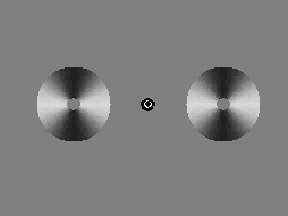Motion-induced Tilt
- After prolonged viewing of the same direction of motion (adaptation),
a static pattern presented at the same location (test) is seen
to move in the opposite direction. This is the
motion aftereffect.
- It has been believed that the motion aftereffect is not accompanied
by concomitant changes in position and spatial pattern. However,
this is not true.
- In the following demonstration, the top and bottom panels
are windmills for adaptation that rotate in the opposite directions
each other. The centre panel is a pair of static windmills for
the test.
- First, move one of the adaptation stimulus by double-clicking
the window, and look at the rotating windmills for 10-20 seconds
with keeping your gaze at the centre bullseye. Next, shift your
gaze to the bullseye of the test stimulus.
- You will then notice that the static windmills appear to
move in the opposite directions by the motion aftereffect. At
the same time, the windmills appear to tilt towards the direction
of apparent movement.
- This apparent tilt suggests the existence of the brain mechanism
that transforms motion information into changes in position and
orientation.


